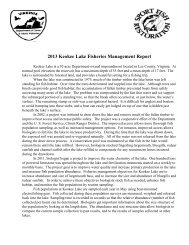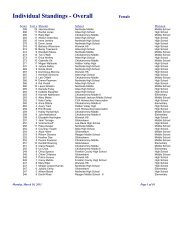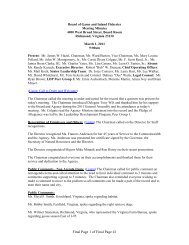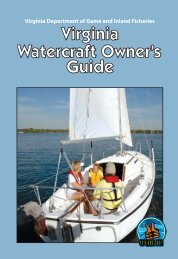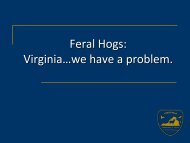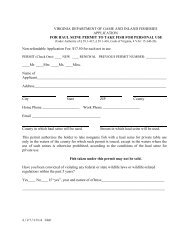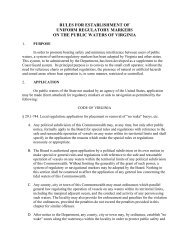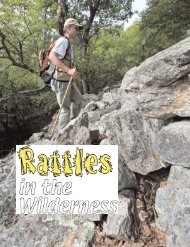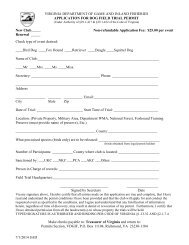2013 Virginia Freshwater Fishing & Watercraft Owner's Guide
2013 Virginia Freshwater Fishing & Watercraft Owner's Guide
2013 Virginia Freshwater Fishing & Watercraft Owner's Guide
You also want an ePaper? Increase the reach of your titles
YUMPU automatically turns print PDFs into web optimized ePapers that Google loves.
<strong>2013</strong> <strong>Fishing</strong> Regs & WOG 11-15-12_Layout 1 11/16/12 1:02 PM Page 58the waterway is reduced to 2 nauticalmiles which is a line drawn from CherryPoint at Gwynns Island across the riverto the opposite shore, which is in thevicinity of Piankatank River LightedBuoy 6.5. Rappahannock River up to where thewaterway is reduced to 2 nautical miles,which is a line drawn from Parrott Islandto Cherry Point, which is just before youget to the first highway bridge.6. Those parts of the Pocomoke andTangier Sounds which fall within <strong>Virginia</strong>.7. Where the uncharted inlets of theAtlantic Ocean are reduced to 2 nauticalmiles in width.Navigation LightsRecreational boats, while underway, arerequired to display navigation lights (seepage 59) between sunset and sunrise andduring periods of restricted visibility.No other lights shall be exhibited thatcould impair the visibility of required runninglights or impair the visibility ofapproaching vessels.Lights Used When AnchoredAn anchor light is a 360 degree (all-round)white light exhibited where it can best beseen and visible for 2 miles.Special Lights for EnforcementVesselsEnforcement vessels of the VDGIF, the USCG,and other law enforcement agencies maydisplay a rotating or flashing blue light.When such a light is observed you shouldstop immediately and maneuver in such away as to permit the boarding officer tocome alongside or aboard.By federal law, blue lights may only bedisplayed by enforcement vessels of the federal,state or local governments, and havethe same effect on the water as the rotatingor flashing blue lights on law enforcementcars traveling our highways.Life Jackets -WearableLife Jackets -Type IVSummary of <strong>Virginia</strong> Boating Equipment RequirementsManually PWC’s Boats Boats Boats BoatsPropelled Under 16 Feet– 26 Feet – 40 Feet–Kayaks and 16 Feet Less Than Less Than 65 FeetCanoes 26 Feet 40 Feet✔ ✔ 1 ✔ ✔ ✔ ✔✔ ✔ ✔Certificate of Number ✔ ✔ 2 ✔ 2 ✔ ✔Validation Decal ✔ ✔ 2 ✔ 2 ✔ ✔Type B-1Fire ExtinguisherType B-IIFire ExtinguisherIgnition Safety SwitchBackfire FlameArrestor✔ ✔ 3 ✔ 3✔✔ 4 ✔ 5✔ ✔ ✔ ✔ ✔Ventilation System ✔ ✔ ✔ ✔ ✔Muffler✔ ✔ ✔ ✔ ✔(inboard engines)Horn, Whistle, or Bell ✔ 8 ✔ ✔ ✔ ✔ ✔Daytime VDS –Operating inCoastal Waters✔ ✔ ✔ ✔(pgs 57–58)Nightime VDS –Operating inCoastal Waters✔ ✔ ✔ ✔ ✔(pgs 57–58)Navigation Lights ✔ 6 ✔ 6 ✔ 6 ✔ 6 ✔ 6Boating SafetyEducationCertificate✔ 7 ✔ 7 ✔ 7 ✔ 7 ✔ 71. The operator, each rider, and anyone being towed behind a PWC must be wearing aUSCG approved Type I, II, III or V life jacket. Inflatable life jackets are prohibited.2. Except non-motorized vessels3. Applies to boats where one of the following conditions exists: permanently installedfuel tanks; closed compartments under thwarts and seats where portable fuel tanksare stored; double bottoms not sealed at the hull or which are not completely filledwith flotation material; closed living spaces; or closed stowage compartment inwhich combustible or flammable materials or stowed.4. Must carry one B-II or two B-1. A fixed system equals one B-1.5. Must carry one B-II and one B-1 or three B-1. A fixed system equals one B-1.6. See pages 58–60.7. Education requirement is being phased in through July 1 2016. See page 61 forphase-in. Applies to all PWCs and all motorboats with engine of 10 hp or greater.8. A sufficient means of making a sound signal (4–6 seconds) in duration.58



